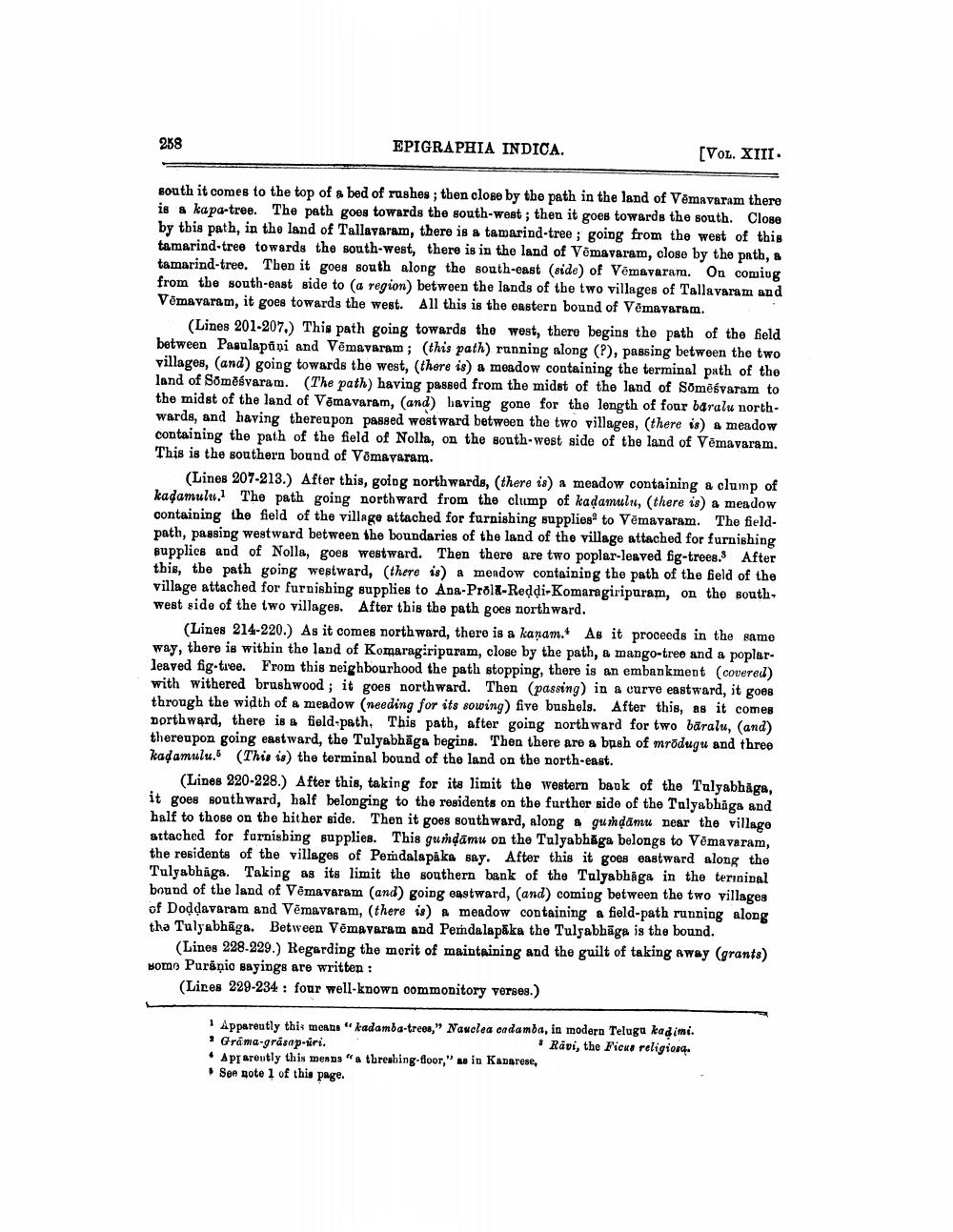________________
258
EPIGRAPHIA INDICA.
[VOL. XIII
south it comes to the top of a bed of rushes; then close by the path in the land of Vēmavaram there is a kapa-tree. The path goes towards the south-west ; then it goes towards the south. Close by this path, in the land of Tallavaram, there is a tamarind-tree; going from the west of this tamarind-tree towards the south-west, there is in the land of Vēmavaram, close by the path, a tamarind-tree. Then it goes south along the south-east (side) of Vēmavaram. On comiug from the south-east side to (a region) between the lands of the two villages of Tallavaram and Vēmavaram, it goes towards the west. All this is the eastern bound of Vēmavaram.
(Lines 201-207.) This path going towards the west, there begins the path of the field between Pasulapani and Vēmavaram ; (this path) running along (?), passing between the two villages, (and) going towards the west, (there is) a meadow containing the terminal path of the land of Somēśvaram. (The path) having passed from the midst of the land of Somēśvaram to the midst of the land of Vāmavaram, (and) having gone for the length of four baralu northwards, and having thereupon passed westward between the two villages, (there is a meadow containing the path of the field of Nolla, on the south-west side of the land of Vēmavaram. This is the southern bound of Vomavaram.
(Lines 207-213.) After this, going northwards, (there is) a meadow containing a clump of kadamults. The path going northward from the clump of kadamului, (there is a meadow containing the field of the village attached for furnishing supplies to Vemavaram. The fieldpath, passing westward between the boundaries of the land of the village attached for furnishing supplies and of Nolla, goes westward. Then there are two poplar-leaved fig-trees. After this, the path going westward, there is a meadow containing the path of the field of the village attached for furnishing supplies to Ada-Prola-Reddi-Komaragiripuram, on the southwest side of the two villages. After this the path goes northward.
(Lines 214-220.) As it comes northward, there is a kanam. As it proceeds in the same way, there is within the land of Komaragiripuram, close by the path, a mango-tree and a poplarleaved fig tree. From this neighbourhood the path stopping, there is an embankment (covered) with withered brushwood; it goes northward. Then (passing) in a curve eastward, it goes through the width of a meadow (needing for its sowing) five bushels. After this, as it comes Dorthward, there is a field-path. This path, after going northward for two bāralu, (and) thereupon going eastward, the Tulyabhāga begins. Then there are a bush of mrõdugu and three kadamulu. (This is the terminal bound of the land on the north-east.
(Lines 220-228.) After this, taking for its limit the western bank of the Tulyabhāga, it goes southward, half belonging to the residents on the further side of the Tulyabhāga and half to those on the hither side. Then it goes southward, along a guidāmu near the village attached for furnishing supplies. This guidāmu on the Tulyabhāga belongs to Vēmavaram, the residents of the villages of Pemdalapäka say. After this it goes eastward along the Tulyabhaga. Taking as its limit the southern bank of the Tulyabhāga in the terminal bound of the land of Vēmavaram (and) going eastward, (and) coming between the two villages of Doddavaram and Vēmavaram, (there is) A meadow containing a field-path running along tha Tulyabhāga. Between Vömavaram and Perdalapika the Tulyabhāga is the bound.
(Lines 228-229.) Regarding the merit of maintaining and the guilt of taking away (grants) somo Purāņio sayings are written:
(Likes 229-234 : four well-known commonitory verses.)
Appareutly this meana" kadamba-trees," Nanclea cadamba, in modern Telugu kadimi. - Grama-gräsap-uri.
* Ravi, the Ficks religion. • Aparently this menns "a threshing-floor," as in Kadarese,
See note 1 of this page.




